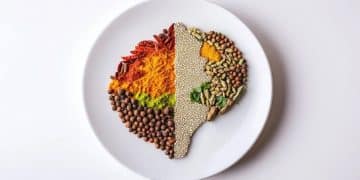The Truth About Sugar: Types, Impact, and Your Health

Navigating the complex landscape of sugar reveals its multifaceted nature: from inherent forms in whole foods to pervasive added sugars in processed items, understanding their diverse biological impacts, from energy provision to chronic disease risk, is crucial for informed dietary choices and long-term well-being, demanding a nuanced approach beyond blanket avoidance.
Delving into The Truth About Sugar: Understanding the Different Types and Their Impact on Your Health reveals a complex and often misunderstood aspect of our daily diets. Far from being a monolithic entity, sugar encompasses a wide range of compounds, each interacting with our bodies in unique ways. This exploration seeks to demystify sugar, offering clarity on its various forms and providing a balanced perspective on its role in nutrition and overall health.
Decoding Sugar: Fundamental Forms and Their Origin
Sugar, in its simplest definition, refers to sweet-tasting, soluble carbohydrates. These are found in various foods, both naturally occurring and added during processing. Understanding the fundamental forms of sugar and their origins is the first step toward grasping its broader impact on health. This foundational knowledge helps differentiate between sugars that are part of whole, unprocessed foods and those that are refined or artificially produced.
Sugars are primarily classified into monosaccharides and disaccharides based on their chemical structure. Monosaccharides, or single sugar units, include glucose, fructose, and galactose. These are the basic building blocks that our bodies absorb directly. Disaccharides, on the other hand, are formed when two monosaccharides bond together. Common disaccharides include sucrose (table sugar), lactose (milk sugar), and maltose (malt sugar). Each of these forms has distinct characteristics and metabolic pathways within the human body.
Monosaccharides: The Simplest Sugars
Monosaccharides are the most basic units of carbohydrates. They are absorbed directly into the bloodstream and are crucial for cellular energy. Their immediate availability makes them vital components of various biological processes.
- Glucose: The most abundant monosaccharide, glucose is the primary source of energy for all body cells, particularly the brain. It is found in fruits, vegetables, and honey, but also circulated in our blood as blood sugar.
- Fructose: Often called “fruit sugar,” fructose is found naturally in fruits, honey, and some vegetables. It is metabolized primarily in the liver, which can lead to different metabolic effects compared to glucose, especially in high amounts.
- Galactose: Less common in its free form, galactose is primarily found as part of lactose, the sugar in milk. It is converted to glucose in the liver for energy use.
These simple sugars provide quick energy, which is why athletes often consume glucose-rich foods. However, the context of their consumption—whether from whole foods or added sugars—significantly influences their health impact.
Disaccharides: Two Sugars Combined
Disaccharides are complex sugars formed when two monosaccharides join through a glycosidic bond. They must be broken down by digestive enzymes into their constituent monosaccharides before they can be absorbed into the bloodstream. This breakdown process can affect the rate at which they enter the bloodstream and thus their immediate impact on blood sugar levels.
- Sucrose: Commonly known as table sugar, sucrose is a disaccharide composed of one glucose molecule and one fructose molecule. It is extracted from sugar cane or sugar beets. This is the sugar most frequently added to processed foods and beverages.
- Lactose: Found in milk and dairy products, lactose is a disaccharide made up of glucose and galactose. Its digestion requires the enzyme lactase, which some individuals lack, leading to lactose intolerance.
- Maltose: Also known as malt sugar, maltose consists of two glucose units. It is produced during the malting process of grains like barley and is found in malt beverages and some processed foods.
While chemically related, the sources and processing of these sugars profoundly alter their effects. Natural sugars in fruits come packaged with fiber, vitamins, and antioxidants, which mitigate the sugar’s impact on blood sugar levels. Added sugars, stripped of these beneficial components, can lead to rapid blood sugar spikes and contribute to various health issues.
Understanding these different forms of sugar and where they originate helps make more informed dietary choices. It highlights the distinction between the sweet component of a whole food and the isolated, concentrated sugars added to processed products. This fundamental knowledge serves as the basis for exploring sugar’s wider implications for our health.
Sources of Sugar: Natural vs. Added Forms
The distinction between naturally occurring sugars and added sugars is paramount when discussing their impact on health. While both provide calories, their nutritional context and metabolic effects can differ dramatically. Natural sugars are intrinsically part of whole foods, whereas added sugars are introduced during processing or preparation, often without accompanying nutrients beneficial to health.
This section explores the primary sources of sugar in the typical diet, emphasizing the critical differences between sugar found in its natural form within fruits, vegetables, and dairy, and the more concerning prevalence of added sugars in processed foods and beverages. Recognizing these sources helps individuals make more conscious dietary decisions.

Natural Sugars: Part of a Wholesome Diet
Natural sugars are the sweetness found inherently in whole, unprocessed foods. These foods, such as fruits, vegetables, and milk, come with a package of essential nutrients designed by nature. The sugars in these foods are accompanied by fiber, vitamins, minerals, and antioxidants, which influence how the body processes the sugar.
- Fruits: Rich in fructose and glucose, fruits also provide a significant amount of dietary fiber. Fiber slows down the absorption of sugar into the bloodstream, preventing rapid spikes in blood glucose levels. They also offer a wealth of vitamins (like Vitamin C), minerals (like potassium), and phytochemicals that contribute to overall health.
- Vegetables: While generally less sweet than fruits, many vegetables contain natural sugars. Root vegetables like carrots and beets have noticeable amounts. They are also packed with fiber, vitamins, and minerals, making them vital for a balanced diet.
- Dairy Products: Milk and unsweetened dairy products contain lactose, a natural sugar. Dairy also provides protein, calcium, potassium, and vitamin D, essential for bone health and other bodily functions.
Consuming natural sugars from these sources is generally considered beneficial due to the accompanying nutritional benefits. The fiber content, in particular, plays a crucial role in moderating sugar absorption and promoting digestive health.
Added Sugars: A Modern Dietary Challenge
Added sugars are any sugars (and syrups) put into foods or beverages during processing or preparation, beyond the sugars naturally present. This category includes common table sugar (sucrose), high-fructose corn syrup, brown sugar, corn syrup, dextrose, and many others. Unlike natural sugars, added sugars typically come without accompanying nutrients, providing “empty calories” that can contribute to health problems when consumed in excess.
- Processed Foods: A vast array of processed foods, from breakfast cereals and baked goods to sauces and frozen meals, contain significant amounts of added sugar. Manufacturers use sugar not only for sweetness but also as a preservative, a texture agent, and to enhance flavor, often masking the true sugar content.
- Sweetened Beverages: Sodas, fruit drinks, energy drinks, and sweetened teas are among the leading sources of added sugar in many diets. These beverages offer little to no nutritional value and are associated with a higher risk of weight gain, type 2 diabetes, and cardiovascular disease. Their liquid form means the sugar is absorbed very quickly, leading to sharp blood sugar spikes.
- Sweets and Desserts: Candies, chocolates, cakes, cookies, and ice cream are obvious sources of added sugar. While often consumed for indulgence, frequent and large portions contribute significantly to overall sugar intake.
The ubiquity of added sugars in the food supply makes it challenging to moderate intake. They contribute to excess calorie consumption without providing satiety, often leading to overeating. Current dietary guidelines recommend limiting intake of added sugars due to their association with various adverse health outcomes.
Understanding the distinction between natural and added sugars is fundamental for anyone aiming to improve their dietary habits. Opting for whole, unprocessed foods whenever possible helps replace empty calories from added sugars with nutrient-dense options that support long-term health.
Metabolism of Sugar: How the Body Processes Different Types
The way our bodies process different types of sugar is a complex biochemical dance, influencing everything from immediate energy levels to long-term metabolic health. Not all sugars are created equal in the eyes of our metabolism; glucose, fructose, and galactose each have distinct pathways and effects once consumed. Understanding these metabolic processes helps clarify why certain sugars might have different health implications, particularly when consumed in varying quantities and forms.
This section delves into the intricate mechanisms by which our bodies break down, absorb, and utilize the various forms of sugar, providing insights into their unique physiological impacts. It aims to clarify how diet influences these processes and what the implications are for our health.
Glucose: The Body’s Preferred Energy Source
Glucose is central to energy metabolism in virtually all living organisms. Once ingested, carbohydrates, regardless of their initial form (starch, sucrose, lactose), are ultimately broken down into glucose. This monosaccharide then becomes the direct fuel for our cells.
Upon absorption from the small intestine, glucose enters the bloodstream, raising blood glucose levels. This rise signals the pancreas to release insulin, a hormone that facilitates the uptake of glucose by cells for immediate energy or its storage as glycogen in the liver and muscles for later use. This tightly regulated process ensures a stable energy supply for the body’s numerous functions.
When glucose is ingested as part of complex carbohydrates (like whole grains) or naturally occurring sugars in fruits (alongside fiber), its absorption is generally slower. This leads to a more gradual rise in blood sugar and a gentler insulin response, promoting stable energy levels and reducing the metabolic strain on the body. Conversely, rapid absorption from simple sugars or refined carbohydrates can lead to sharp peaks and valleys in blood sugar, potentially contributing to insulin resistance over time.
Fructose: A Divergent Metabolic Path
Unlike glucose, fructose follows a largely different metabolic pathway, primarily in the liver. While small amounts of fructose can be metabolized by other tissues, the liver is the main site for converting fructose into glucose, glycogen, or—if consumed in excessive amounts—into triglycerides (fats).
The key distinction lies in fructose’s limited ability to directly stimulate insulin release. Although it does not directly spike blood sugar like glucose, its metabolism in the liver can have significant downstream effects. When liver glycogen stores are full, excess fructose is preferentially converted to fat, which can accumulate in the liver (contributing to non-alcoholic fatty liver disease) and be released into the bloodstream as very low-density lipoproteins (VLDL), raising triglyceride levels.
The context of fructose consumption is crucial. Fructose consumed in whole fruits, accompanied by fiber and other nutrients, is metabolized differently due to slower absorption and smaller quantities compared to the concentrated fructose found in high-fructose corn syrup or added sugars in processed foods. High consumption of added fructose from sweetened beverages and processed foods is particularly concerning due to its potential to contribute to metabolic syndrome, insulin resistance, and cardiovascular issues.
Galactose: Milk’s Unique Sugar Component
Galactose is a monosaccharide derived almost exclusively from the digestion of lactose, the sugar found in milk. Once lactose is broken down in the small intestine by the enzyme lactase, galactose is absorbed and transported to the liver.
In the liver, galactose is efficiently converted into glucose through a series of enzymatic reactions, making it ultimately available for energy or storage. This conversion ensures that galactose does not accumulate in the body to harmful levels in most individuals. However, for those with rare inherited metabolic disorders, such as galactosemia, the inability to properly metabolize galactose can lead to severe health problems, including liver damage and developmental issues.
For the general population, galactose from dairy products contributes to overall carbohydrate intake in a way that is metabolically similar to glucose, once converted. The nutritional benefits of dairy, including protein and calcium, often outweigh concerns about its sugar content when consumed as part of a balanced diet.
The varied metabolic fates of glucose, fructose, and galactose underscore the complexity of sugar’s role in our diets. While all provide energy, their distinct processing routes contribute to different physiological responses. This understanding reinforces the importance of considering not just the quantity but also the type and origin of sugars in our diet for optimal health management.
Health Implications: The Broad Spectrum of Sugar’s Impact
The impact of sugar on human health extends far beyond simple calorie intake, touching upon a wide array of physiological systems and chronic disease risks. While moderate consumption of naturally occurring sugars within whole foods is generally harmless, excessive intake of added sugars has been linked to numerous adverse health outcomes. Understanding the broad spectrum of these implications is vital for making informed dietary choices and promoting long-term well-being.
This section explores the various ways in which sugar, particularly in its added forms, can influence weight management, metabolic function, cardiovascular health, and even neurological processes. It aims to provide a comprehensive overview of the scientific evidence linking sugar consumption to disease, offering context for why moderation and careful sourcing are crucial.
Weight Gain and Obesity: A Caloric Overload
One of the most direct and widely recognized impacts of excessive sugar consumption is its contribution to weight gain and obesity. Added sugars provide calories without offering significant satiety, leading to overconsumption. Sugary beverages, in particular, are notorious for this, as liquid calories are often not registered by the body in the same way as solid food calories, easily leading to an energy surplus.
The high fructose content in many added sugars can further exacerbate this issue. As discussed, excess fructose is converted to fat in the liver, which can lead to increased fat storage, particularly visceral fat around organs, which is metabolically active and linked to higher disease risk. This contributes to a positive energy balance where caloric intake exceeds expenditure, ultimately resulting in weight accumulation.
Chronic overconsumption of sugar can also disrupt the body’s natural hunger and satiety signals, making it harder to regulate food intake. This creates a cycle where sugary foods are consumed more frequently, further contributing to weight gain and the global obesity epidemic.
Insulin Resistance and Type 2 Diabetes: A Disturbed Metabolic Harmony
Persistent high intake of added sugars places a continuous burden on the pancreas, requiring it to produce more and more insulin to manage elevated blood glucose levels. Over time, cells can become less responsive to insulin’s signals, a condition known as insulin resistance. This is a key precursor to type 2 diabetes, where the body either doesn’t produce enough insulin or can’t effectively use the insulin it produces.
Beyond its direct impact on blood glucose, chronic fructose overload in the liver can also contribute to insulin resistance. The fat accumulation triggered by excess fructose metabolism can impair insulin signaling in liver cells, spreading its effects throughout the body. The link between high added sugar intake, particularly from sweetened beverages, and the increased risk of type 2 diabetes is well-established in scientific literature.
Cardiovascular Disease: Beyond Just Weight
The connection between sugar and cardiovascular disease (CVD) is now increasingly recognized as independent of its role in weight gain. High sugar intake, especially from fructose-containing sugars, can detrimentally affect several markers of heart health.
- Elevated Triglycerides: As mentioned, excess fructose is readily converted to triglycerides in the liver, leading to elevated levels in the blood, a known risk factor for CVD.
- Increased Blood Pressure: Some research suggests that high sugar intake can directly contribute to elevated blood pressure, another major risk factor for heart disease.
- Inflammation: Chronic high sugar consumption promotes systemic inflammation, a process implicated in the development and progression of atherosclerosis (hardening of the arteries).
- Cholesterol Imbalance: While saturated fats have traditionally been blamed, excessive sugar intake can lead to an unfavorable lipid profile, increasing LDL (“bad”) cholesterol and lowering HDL (“good”) cholesterol.
These combined effects highlight why limiting added sugar is crucial for maintaining heart health, even for individuals who are not overweight or obese.
Other Health Concerns: A Cascade of Effects
The detrimental effects of excessive sugar consumption extend to various other aspects of health:
- Dental Caries: Sugar provides a ready food source for bacteria in the mouth, which produce acids that erode tooth enamel, leading to cavities. Frequency of consumption is as important as quantity.
- Non-Alcoholic Fatty Liver Disease (NAFLD): The liver’s preference for metabolizing fructose can lead to fat accumulation, potentially progressing to inflammation and liver damage, mirroring effects seen in alcoholic liver disease.
- Increased Risk of Certain Cancers: While research is ongoing, increased sugar intake, often linked to obesity and insulin resistance, is associated with a higher risk of several types of cancer.
- Impact on Mood and Cognitive Function: Rapid blood sugar fluctuations from high sugar intake can contribute to mood swings, anxiety, and impaired cognitive function, often described as a “sugar crash.” Chronic sugar consumption can also negatively affect brain health and contribute to neuroinflammation.
The pervasive nature of added sugars in the modern diet makes these health concerns particularly relevant. Recognizing the extensive impacts of sugar on health underscores the importance of a mindful approach to dietary intake, favoring whole foods and minimizing highly processed, sugar-laden products.
Navigating the Sugar Landscape: Informed Choices for Health
Given the pervasive nature of sugar in our food supply and its complex impact on health, navigating the sugar landscape effectively requires more than just avoiding “sweets.” It demands an informed approach, a critical eye for food labels, and a commitment to whole, unprocessed foods. Making conscious choices about sugar intake is not about demonizing an entire food component but about understanding its role and mitigating potential harm from excessive consumption, particularly of added sugars.
This section provides practical strategies and considerations for individuals seeking to manage their sugar intake effectively, emphasizing dietary patterns over rigid restriction, and highlighting the importance of balanced nutrition for long-term health.
Reading Labels: Unmasking Hidden Sugars
The first step toward reducing added sugar intake is becoming adept at reading food labels. Sugar can appear under many guises, often making it difficult to identify its presence and quantity. Manufacturers use over 200 different names for added sugars, ranging from common ones to less obvious syrups and concentrates.
- Look at the Ingredients List: Ingredients are listed in descending order by weight. If sugar or any of its aliases appear early in the list, the product likely contains a significant amount. Be aware of multiple forms of sugar used in a single product, as individually they might appear lower on the list, but collectively they add up.
- Understand Sugar Aliases: Common aliases include high-fructose corn syrup, corn syrup, dextrose, glucose, sucrose, maltose, evaporated cane juice, fruit juice concentrates, honey, molasses, maple syrup, agave nectar, brown rice syrup, and many others.
- Check the Nutrition Facts Panel: The “Added Sugars” line under “Total Sugars” is crucial. This number, often expressed in grams (g) and as a percentage of Daily Value (%DV), directly tells you how much sugar has been added to the product. The American Heart Association recommends limiting added sugar intake to about 25 grams (6 teaspoons) per day for women and 36 grams (9 teaspoons) for men.
Becoming a savvy label reader empowers consumers to make choices that align with their health goals, moving beyond marketing claims to factual nutritional information.
Prioritizing Whole Foods: The Foundation of a Low-Sugar Diet
The most effective strategy for managing sugar intake is to build a diet around whole, unprocessed foods. These foods are naturally lower in added sugars and often rich in fiber, which helps moderate the absorption of any naturally occurring sugars. This approach contrasts sharply with reliance on highly processed foods, which are a major source of hidden sugars.
- Embrace Fruits and Vegetables: While fruits contain natural sugars, their fiber and nutrient content make them a far superior choice to sugary snacks or desserts. Incorporate a wide variety of colorful fruits and vegetables into daily meals.
- Choose Unprocessed Grains: Opt for whole grains like oats, brown rice, quinoa, and whole wheat bread over refined grains, which often have added sugars and lack fiber.
- Select Unsweetened Dairy: Choose plain yogurt, milk, or dairy alternatives and sweeten them yourself with fruit or a tiny bit of natural sweetener if desired, rather than buying pre-sweetened versions.
- Cook at Home: Preparing meals from scratch gives you full control over the ingredients, allowing you to avoid added sugars commonly found in restaurant and pre-packaged foods.
By focusing on whole foods, you naturally reduce your exposure to added sugars while increasing your intake of essential nutrients.
Moderation and Mindful Consumption: A Balanced Approach
Complete sugar abstinence is often unrealistic and unnecessary for most individuals. Instead, a focus on moderation and mindful consumption is a more sustainable and healthy approach. This involves enjoying treats occasionally and in smaller portions, rather than cutting them out entirely, which can lead to cravings and bingeing.
- Reduce Sweetened Beverages: This is often the easiest and most impactful step to reducing added sugar intake. Replace sodas, energy drinks, and sweetened juices with water, unsweetened tea, or naturally flavored sparkling water.
- Be Aware of Portion Sizes: Even with naturally sweet foods, portion control matters. A large fruit smoothie, for example, can contain a significant amount of sugar if multiple servings of fruit are blended without their accompanying fiber.
- Identify and Break Habits: Many sugar cravings are tied to habits or emotional triggers. Identifying these patterns and finding healthier alternatives for stress relief or routine snacks can be very effective.
- Gradual Reduction: If consuming large amounts of sugar, try gradually reducing intake rather than cutting it out completely. This allows your taste buds to adjust and makes the transition easier.
Navigating the sugar landscape successfully requires a blend of knowledge, vigilance, and practical strategies. By understanding the different types of sugar, reading labels carefully, prioritizing whole foods, and practicing moderation, individuals can significantly improve their dietary quality and overall health, moving towards a more balanced and sustainable relationship with sugar.
The Future of Sugar: Emerging Alternatives and Dietary Trends
As awareness of the health implications of excessive sugar consumption grows, the food industry and consumers alike are seeking viable alternatives and adopting new dietary trends aimed at reducing sugar intake. This evolving landscape presents both opportunities and challenges, with a growing array of sugar substitutes, natural low-calorie sweeteners, and innovative food product developments. Understanding these emerging trends provides insight into the potential future of our diets and the ongoing effort to balance sweetness with health.
This section explores some of the key developments in sugar alternatives and prevailing dietary patterns that aim to mitigate the negative effects of sugar, fostering a healthier approach to food without sacrificing taste.
Novel Sweeteners: Beyond Aspartame and Stevia
The market for sugar alternatives is rapidly expanding, driven by consumer demand for low-calorie or no-calorie options that mimic the taste of sugar without its associated health risks. Beyond traditional artificial sweeteners like aspartame and saccharin, and natural alternatives such as stevia, newer options are gaining traction.
- Erythritol and Xylitol: These are sugar alcohols, naturally found in some fruits and fermented foods. They are much lower in calories than sugar and do not raise blood sugar levels significantly. They are often used in “sugar-free” candies, gums, and baked goods due to their similar texture and bulk to sugar. However, in large quantities, they can cause digestive discomfort in some individuals.
- Monk Fruit Extract: Derived from the monk fruit, a small melon native to Southeast Asia, this sweetener is also calorie-free and significantly sweeter than sugar. It’s gaining popularity for its natural origin and lacks the bitter aftertaste sometimes associated with stevia.
- Allulose: A “rare sugar,” allulose is a naturally occurring monosaccharide found in small amounts in wheat, fruits like figs and raisins. It has about 70% of the sweetness of sucrose but only 10% of the calories and does not significantly impact blood glucose or insulin levels. Its functional properties are very similar to sugar, making it ideal for baking and food manufacturing.
The development of these novel sweeteners aims to provide options that not only taste good but also align with health-conscious consumer preferences. However, long-term studies on the metabolic effects of some of these newer alternatives are still emerging.
Trending Dietary Patterns for Sugar Reduction
Beyond specific sweeteners, various dietary patterns are gaining popularity for their emphasis on reducing sugar intake. These approaches often prioritize whole foods and can be adapted to individual needs and preferences.
- Low-Carbohydrate and Ketogenic Diets: While not exclusively focused on sugar, these diets drastically reduce carbohydrate intake, which naturally leads to a significant reduction in sugar consumption. By shifting the body’s primary fuel source from carbohydrates to fats, they aim to improve metabolic markers, including blood sugar control and insulin sensitivity.
- Paleo and Whole30 Approaches: These diets focus on eliminating processed foods, grains, legumes, and dairy, naturally cutting out most added sugars and refined carbohydrates. They emphasize lean meats, fish, fruits, vegetables, nuts, and seeds, encouraging consumption of nutrient-dense whole foods.
- The Mediterranean Diet: Although not specifically a “low-sugar” diet, the Mediterranean pattern naturally encourages low added sugar intake by emphasizing whole grains, fruits, vegetables, healthy fats, and lean proteins, while limiting processed foods and sweets. This approach has long been associated with various health benefits, including reduced risk of chronic diseases.
- Mindful Eating and Intuitive Eating: These approaches emphasize listening to the body’s hunger and fullness cues and eating with awareness, rather than following strict rules. While not explicitly about sugar, they can help individuals identify and address emotional eating triggered by sugar cravings, fostering a healthier relationship with food.
These trends reflect a broader societal shift towards more conscious eating, where the source and processing of food are increasingly considered alongside its taste and caloric content. The ongoing innovation in sweeteners and the adoption of healthier eating patterns indicate a promising future for reducing the impact of excessive sugar on global health. However, the foundational principle remains: a diet rich in whole, unprocessed foods is the most reliable path to wellness.
Practical Strategies: Reducing Sugar in Everyday Life
Successfully reducing sugar intake in daily life requires practical, actionable strategies that can be integrated into existing routines without feeling overly restrictive. It’s not about achieving perfection overnight, but rather about making gradual, sustainable changes that lead to healthier habits over time. The ubiquity of added sugars in the modern food supply means conscious effort is needed to navigate grocery stores, meal preparations, and dining out effectively.
This section offers straightforward, applicable tips for individuals looking to minimize their sugar consumption, ranging from simple swaps to more systemic changes in dietary patterns. These strategies focus on empowering individuals with the tools to make healthier choices consistently.
Smart Swaps in the Kitchen and Grocery Store
One of the most effective ways to reduce sugar is to make smart substitutions for high-sugar items with healthier alternatives. This applies to both what you buy at the grocery store and how you prepare food at home.
- Beverages:
- Swap sugary sodas, fruit juices (even 100% juice can be high in natural sugars without fiber), and sweetened teas for water, unsweetened sparkling water with a slice of lemon or cucumber, unsweetened herbal tea, or black coffee.
- For smoothies, use whole fruits and vegetables, and avoid adding extra honey, agave, or syrups.
- Breakfast Foods:
- Instead of sugary cereals, opt for plain oatmeal or whole-grain unsweetened cereals. Sweeten with fresh fruit, a sprinkle of cinnamon, or a few nuts.
- Choose plain Greek yogurt over flavored, sugar-laden varieties and add your own fruit, nuts, or a tiny amount of natural sweetener if desired.
- Snacks:
- Replace cookies, cakes, and candy bars with fresh fruit, nuts, seeds, vegetable sticks with hummus, or plain popcorn.
- When craving something sweet, try a piece of dark chocolate (70% cocoa or higher) in moderation.
- Cooking and Baking:
- Gradually reduce the amount of sugar in recipes. Often, you can cut sugar by 25-50% in recipes without significantly affecting taste or texture.
- Use natural flavorings like vanilla extract, almond extract, or spices (cinnamon, nutmeg, cardamom) to enhance sweetness without adding sugar.
- Incorporate fruits like bananas, dates, or applesauce for natural sweetness and moisture in baked goods.
- Be Proactive with Menus:
- Scan menus ahead of time if possible to identify lower-sugar options.
- Don’t hesitate to ask for modifications, such as dressing on the side (most dressings are loaded with sugar) or unsweetened alternatives for beverages.
- Mind Portion Sizes:
- Restaurant portions are often oversized. Consider sharing a dessert or opting for a fruit-based option when available.
- Be mindful of hidden sugars in sauces, marinades, and breadings. Choose grilled, baked, or steamed dishes over fried ones.
- Navigating Social Events:
- If attending a party or gathering, offer to bring a sugar-free or low-sugar dish to ensure there’s a healthy option available.
- Prioritize conversation and connection over food. Often, we mindlessly graze at social events.
- Politely decline sugary offerings, or take a small portion to be polite and focus on enjoying the company.
- Stay Hydrated: Drinking plenty of water can help manage cravings and mitigate some withdrawal symptoms.
- Eat Regular, Balanced Meals: This prevents extreme hunger that can lead to impulsive, sugary choices. Include protein, fiber, and healthy fats to promote satiety.
- Find Non-Food Rewards: Instead of turning to sugar for comfort or reward, find other ways to de-stress or celebrate, such as exercise, hobbies, or spending time with loved ones.
- Acknowledge Progress: Every small step towards reducing sugar intake is a victory. Focus on progress, not perfection, and be kind to yourself throughout the process.
-
Cue: This could be anything from a specific time of day (e.g., afternoon slump), a location (e.g., passing a bakery), an emotion (e.g., feeling stressed or bored), or even other foods (e.g., finishing a savory meal).
-
Routine: The act of seeking out and consuming sugary foods or drinks in response to the cue.
-
Reward: The immediate, albeit temporary, pleasure and energy boost from the sugar, reinforcing the habit loop.
- Identify Your Cues: Pay attention to when and why you crave sugar. Is it tied to stress? Boredom? Certain times of day? Understanding your triggers is the first step.
- Find Healthy Replacements for the Routine: Once you identify a cue, try to insert a new, healthier routine. For an afternoon slump, instead of reaching for a candy bar, try taking a brisk walk, drinking a glass of water, or having a piece of fruit with some nuts.
- Seek Alternative Rewards: The reward doesn’t have to be food. Find non-food ways to de-stress, celebrate, or boost your mood, such as listening to music, engaging in a hobby, practicing mindfulness, or connecting with friends.
- Practice Mindful Eating: When you do consume something sweet, do so mindfully. Savor each bite, pay attention to the flavors and textures, and stop when you feel satisfied, rather than mindlessly consuming.
- Address Emotional Eating: If sugar is used as a coping mechanism for emotions, exploring healthier ways to manage stress, anxiety, or sadness through counseling, journaling, or other self-care practices can be profoundly helpful.
- Be Patient and Persistent: Breaking long-standing habits takes time and consistent effort. There will be setbacks, but consistency over time is what leads to lasting change.
These simple swaps help retrain taste buds to appreciate less intense sweetness and reduce overall sugar intake without feeling deprived.
Dining Out and Social Situations
Managing sugar intake can be particularly challenging when dining out or in social settings. However, with a few conscious strategies, it’s possible to maintain your health goals.
These strategies empower you to make informed decisions and maintain control over your sugar intake, even when environmental factors are challenging.
Listen to Your Body and Be Patient
Reducing sugar can sometimes lead to temporary withdrawal symptoms like headaches or cravings. It’s important to be patient with yourself and listen to your body’s signals.
By implementing these practical strategies, individuals can effectively reduce their sugar intake, improve their overall health, and cultivate a more balanced and sustainable relationship with food.
The Psychological Aspect of Sugar: Cravings and Habits
Beyond its physiological effects, sugar exerts a powerful influence on our psychology, often manifesting as intense cravings and deeply ingrained habits. Understanding this psychological dimension is crucial for effectively managing sugar intake. Our relationship with sugar is not merely about taste preference; it’s shaped by biology, learned behaviors, emotional states, and environmental cues. Breaking free from excessive sugar consumption often requires addressing these underlying psychological factors as much as the nutritional ones.
This section explores the science behind sugar cravings, the formation of sugar-related habits, and provides actionable insights into how to navigate the psychological landscape of sugar for more sustainable change.
The Rollercoaster of Cravings: Brain Chemistry and Blood Sugar Swings
Sugar’s impact on brain chemistry is a primary driver of cravings. When we consume sugar, it triggers the release of dopamine, a neurotransmitter associated with pleasure and reward, in the brain’s reward centers. This can create a powerful positive feedback loop, encouraging repeated consumption to achieve that same pleasurable sensation.
Adding to this, the rapid absorption of simple sugars leads to a quick spike in blood glucose, followed by a subsequent crash. This dip in blood sugar can trigger feelings of fatigue, irritability, and hunger, prompting a renewed craving for sugar to quickly restore energy levels. This creates a “sugar roller coaster” where individuals find themselves caught in a cycle of craving, consumption, crash, and then renewed craving. Over time, the brain can adapt, requiring more sugar to achieve the same reward sensation, potentially leading to a form of dependence.
Furthermore, stress can exacerbate sugar cravings. Cortisol, the “stress hormone,” can increase the desire for comfort foods, often high in sugar and fat, as a way to self-soothe. This highlights the intricate link between our emotional state and dietary choices.
Habit Formation: The Power of Cues, Routines, and Rewards
Many aspects of sugar consumption are driven by habit. Habits are formed through a three-part loop: a cue, a routine, and a reward. For sugar, this often plays out as follows:
These habits can become deeply ingrained, making it feel difficult to break free, even when aware of the negative health consequences. The convenience and availability of sugary foods in our environment further reinforce these habit loops, as the “routine” part of the loop becomes effortless. Breaking these habits requires conscious effort to identify the cues and replace the routine with a healthier alternative that still offers a satisfying reward.
Strategies for Breaking the Cycle: Awareness and Replacement
Successfully managing the psychological aspect of sugar requires a multi-pronged approach focused on awareness, replacement, and patience:
By understanding and addressing the psychological dimensions of sugar cravings and habits, individuals can develop a more empowered and sustainable relationship with food, moving towards dietary patterns that truly support their well-being.
| Key Point | Brief Description |
|---|---|
| 🔬 Types of Sugar | Monosaccharides (glucose, fructose, galactose) and disaccharides (sucrose, lactose, maltose) differ in structure & metabolism. |
| 🍎 Natural vs. Added | Critical distinction exists between sugars naturally present in whole foods (with fiber/nutrients) and isolated, added sugars in processed items. |
| ⚡ Health Impact | Excess added sugar links to weight gain, insulin resistance, type 2 diabetes, heart disease, and fatty liver. |
| 🛒 Smart Choices | Prioritize whole foods, diligently read labels for hidden sugars, and make mindful swaps for better long-term health. |
FAQs About Sugar and Health
▼
Natural sugars are intrinsically found in whole, unprocessed foods like fruits and vegetables, bundled with fiber, vitamins, and minerals that moderate their absorption and offer nutritional benefits. Added sugars, however, are introduced during food processing and provide calories without significant nutritional value, leading to quicker absorption and potential health issues when consumed excessively.
▼
Fructose from whole fruits is generally not considered “bad” due to its low concentration and the accompanying fiber that slows absorption. However, high-fructose corn syrup and other added forms of fructose, when consumed in large quantities, are metabolized primarily by the liver and can contribute to fatty liver, increased triglycerides, and insulin resistance, underscoring the importance of context.
▼
Sugar contributes to weight gain primarily by providing empty calories that often don’t trigger satiety as effectively as whole foods. Liquid sugars, like those in sodas, are particularly problematic as they don’t fill you up, leading to higher overall calorie intake. Excess fructose also readily converts to fat in the liver, contributing to fat accumulation.
▼
Hidden sugars go by many names on food labels, making them difficult to spot. Common aliases include high-fructose corn syrup, corn syrup, dextrose, invert sugar, malt syrup, molasses, raw sugar, evaporated cane juice, fruit juice concentrate, and various “ose” endings like glucose, sucrose, and maltose. Always check the “Added Sugars” line in the Nutrition Facts panel.
▼
Yes, reducing sugar intake can significantly stabilize mood and energy levels. High sugar consumption leads to rapid blood sugar spikes followed by crashes, causing irritability, fatigue, and “brain fog.” By cutting back on added sugars, blood glucose levels become more stable, leading to more consistent energy, improved focus, and a reduction in mood swings throughout the day.
Conclusion
The journey into The Truth About Sugar: Understanding the Different Types and Their Impact on Your Health reveals that our relationship with this ubiquitous substance is far more intricate than often perceived. It’s not simply about sugar versus no sugar, but about discerning between natural forms within nourishing whole foods and the pervasive, often detrimental, presence of added empty calories in processed items. By understanding the diverse metabolic pathways of glucose and fructose, recognizing the broad health implications of excessive intake—from metabolic disorders to cardiovascular risks—and adopting practical strategies for mindful consumption, we empower ourselves to make informed dietary choices. Embracing whole foods, reading labels diligently, and acknowledging the psychological aspects of cravings offer a sustainable path to enhanced well-being, paving the way for a healthier future that balances the enjoyment of sweetness with the imperatives of good health.





